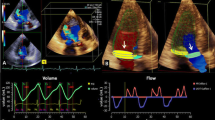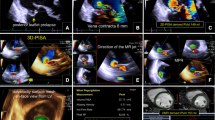Abstract
The present study aimed to evaluate the feasibility and accuracy of chronic aortic regurgitation (CAR) quantification using left and right ventricular stroke volumes (LVSV and RVSV, respectively) obtained from two new automated three-dimensional transthoracic echocardiographic software—Dynamic HeartModel (DHM) and 3D Auto RV. Patients (n=116) with more than mild isolated CAR were included and divided into two groups: central (n=53) and eccentric CAR (n=63) groups. LVSV and RVSV were automatically measured by DHM and 3D Auto RV. Next, aortic regurgitant volume (ARVol) was calculated three ways: as the difference between LVSV and RVSV, by the two-dimensional proximal isovelocity surface area (PISA) method, and using effective regurgitant orifice area derived from real-time three-dimensional echocardiography (RT3DE) multiplied by CAR velocity time integral (the reference standard). DHM plus 3D Auto RV correlated well with RT3DE in ARVol measurement in both groups (central, r = 0.90; eccentric, r = 0.96), with no significant difference based on consistency analysis. In the eccentric group, PISA led to an obvious underestimation (mean difference= − 4.20 ml, P < 0.05). The kappa agreement between DHM plus 3D Auto RV and RT3DE in grading CAR severity in both groups was good (central, k = 0.89; eccentric, k = 0.86), but that between PISA and RT3DE in the eccentric CAR group was suboptimal (k = 0.74). This study indicates that ARVol quantification using DHM plus 3D Auto RV is feasible and reproducible in patients with more than mild isolated CAR. This new method has great correlation and agreement with RT3DE in ARVol measurement, with evident advantages over PISA in eccentric CAR.




Similar content being viewed by others
Data availability
The datasets supporting the results of this study are available from the corresponding author on reasonable request.
Code availability
Not applicable.
References
Vahanian A, Alfieri O, Andreotti F et al (2012) Guidelines on the management of valvular heart disease (version 2012). Eur Heart J 33:2451–2496
Zoghbi WA, Adams D, Bonow RO et al (2017) Recommendations for noninvasive evaluation of native valvular regurgitation: a report from the American society of echocardiography developed in collaboration with the society for cardiovascular magnetic resonance. J Am Soc Echocardiogr 30:303–371
Lancellotti P, Tribouilloy C, Hagendorff A et al (2013) Recommendations for the echocardiographic assessment of native valvular regurgitation: an executive summary from the European association of cardiovascular imaging. Eur Heart J—Cardiovasc Imaging 14:611–644
Thavendiranathan P, Liu S, Datta S et al (2012) Automated quantification of mitral inflow and aortic outflow stroke volumes by three-dimensional real-time volume color-flow Doppler transthoraci echocardiography: comparison with pulsed-wave Doppler and cardiac magnetic resonance imaging. J Am Soc Echocardiogr 25:56–65
Dorosz JL, Lezotte DC, Weitzenkamp DA, Allen LA, Salcedo EE (2012) Performance of 3-dimensional echocardiography in measuring left ventricular volumes and ejection fraction. J Am Coll Cardiol 59:1799–1808
Leibundgut G, Rohner A, Grize L et al (2010) Dynamic assessment of right ventricular volumes and function by real-time three-dimensional echocardiography: a comparison study with magnetic resonance imaging in 100 adult patients. J Am Soc Echocardiogr 23:116–126
Tsang W, Salgo IS, Medvedofsky D et al (2016) Transthoracic 3D echocardiographic left heart chamber quantification using an automated adaptive analytics algorithm. JACC Cardiovasc Imaging 9:769–782
Tamborini G, Piazzese C, Lang RM et al (2017) Feasibility and accuracy of automated software for transthoracic Three-Dimensional left ventricular volume and function analysis: comparisons with two-dimensional echocardiography, three-dimensional transthoracic manual method, and cardiac magnetic resonance imaging. J Am Soc Echocardiogr 30:1049–1058
Medvedofsky D, Mor-Avi V, Amzulescu M et al (2018) Three-dimensional echocardiographic quantification of the left-heart chambers using an automated adaptive analytics algorithm: Multicentre validation study. Eur Heart J Cardiovasc Imaging 19:47–58
Narang A, Mor-Avi V, Prado A et al (2019) Machine learning based automated dynamic quantification of left heart chamber volumes. Eur Heart J Cardiovasc Imaging 20:541–549
Amadieu R, Hadeed K, Jaffro M et al (2019) Feasibility of new transthoracic three-dimensional echocardiographic automated software for left heart chamber quantification in children. J Am Soc Echocardiogr 32:121–134
Genovese D, Rashedi N, Weinert L et al (2019) Machine Learning-Based Three-Dimensional echocardiographic quantification of right ventricular size and function: Validation against cardiac magnetic resonance. J Am Soc Echocardiogr 32:969–977
Otani K, Nabeshima Y, Kitano T, Takeuchi M (2020) Accuracy of fully automated right ventricular quantification software with 3D echocardiography: direct comparison with cardiac magnetic resonance and semi-automated quantification software. Eur Heart J Cardiovasc Imaging 21:787–795
Ewe SH, Delgado V, van der Geest R et al (2013) Accuracy of three-dimensional versus two-dimensional echocardiography for quantification of aortic regurgitation and validation by three-dimensional three-directional velocity-encoded magnetic resonance imaging. Am J Cardiol 112:560–566
Perez DIL, Zamorano J, Fernandez-Golfin C et al (2013) 3D color-Doppler echocardiography and chronic aortic regurgitation: a novel approach for severity assessment. Int J Cardiol 166:640–645
Mitchell C, Rahko PS, Blauwet LA et al (2019) Guidelines for performing a comprehensive transthoracic echocardiographic examination in adults: recommendations from the American society of echocardiography. J Am Soc Echocardiogr 32:1–64
Pouleur A, de Waroux JLP, Goffinet C et al (2008) Accuracy of the flow convergence method for quantification of aortic regurgitation in patients with central versus eccentric jets. Am J Cardiol 102:475–480
Wang W, Lin Q, Wu W, Jiang Y, Lan T, Wang H (2014) Quantification of mitral regurgitation by general imaging three-dimensional quantification: feasibility and accuracy. J Am Soc Echocardiogr 27:268–276
Medvedofsky D, Mor-Avi V, Byku I et al (2017) Three-dimensional echocardiographic automated quantification of left heart chamber volumes using an adaptive analytics algorithm: feasibility and impact of image quality in nonselected patients. J Am Soc Echocardiogr 30:879–885
Detaint D, Messika-Zeitoun D, Maalouf J et al (2008) Quantitative echocardiographic determinants of clinical outcome in asymptomatic patients with aortic regurgitation. JACC: Cardiovascular Imaging 1:1–11
Tribouilloy CM, Enriquez-Sarano M, Fett SL, Bailey KR, Seward JB, Tajik AJ (1998) Application of the proximal flow convergence method to calculate the effective regurgitant orifice area in aortic regurgitation. J Am Coll Cardiol 32:1032–1039
Singh JP, Evans JC, Levy D et al (1999) Prevalence and clinical determinants of mitral, tricuspid, and aortic regurgitation (the Framingham heart study). Am J Cardiol 83:897–902
Yang Y, Wang Z, Chen Z et al (2021) Current status and etiology of valvular heart disease in China: a population-based survey. BMC Cardiovasc Disord 21:339
Marechaux S, Le Goffic C, Ennezat PV et al (2014) Quantitative assessment of primary mitral regurgitation using left ventricular volumes: a three-dimensional transthoracic echocardiographic pilot study. Eur Heart J—Cardiovasc Imaging 15:1133–1139
Levy F, Marechaux S, Iacuzio L et al (2018) Quantitative assessment of primary mitral regurgitation using left ventricular volumes obtained with new automated three-dimensional transthoracic echocardiographic software: a comparison with 3-Tesla cardiac magnetic resonance. Arch Cardiovasc Dis 111:507–517
Kitano T, Nabeshima Y, Otsuji Y, Negishi K, Takeuchi M (2019) Accuracy of left ventricular volumes and ejection fraction measurements by contemporary three-dimensional echocardiography with semi- and fully automated software: systematic review and meta-analysis of 1,881 subjects. J Am Soc Echocardiogr 32:1105–1115
Zeng X, Levine RA, Hua L et al (2011) Diagnostic value of vena contracta area in the quantification of mitral regurgitation severity by color Doppler 3D echocardiography. Circ Cardiovasc Imaging 4:506–513
Thavendiranathan P, Phelan D, Thomas JD, Flamm SD, Marwick TH (2012) Quantitative assessment of mitral regurgitation: validation of new methods. J Am Coll Cardiol 60:1470–1483
Acknowledgements
We thank Elizabeth Sung, PhD, from American Journal Experts (https://www.aje.com) for editing the English text of a draft of the manuscript.
Funding
This research was funded by the Peking Union Medical College Graduate Student Innovation Fund (2019-1002-75).
Author information
Authors and Affiliations
Contributions
Conceptualization: BZ, QM, HW; Methodology: BZ, HW, WW; Data acquisition, analysis, and interpretation: BZ, JT, HL, WW; Writing—original draft preparation: BZ; Writing—review and editing: WW, ZZ, HW; Funding acquisition: BZ, HW; Supervision: WW, HW.
Corresponding author
Ethics declarations
Conflict of interest
The authors declare that they have no conflicts of interest.
Ethical approval
Approval was obtained from our institutional review board. All procedures performed in this study involving human participants were in accordance with the ethical standards of the institutional research committee and with the 1964 Helsinki Declaration.
Consent to participate
Informed consent was obtained from all individual participants included in the study.
Consent for publication
Not applicable.
Additional information
Publisher’s Note
Springer Nature remains neutral with regard to jurisdictional claims in published maps and institutional affiliations.
Rights and permissions
About this article
Cite this article
Zhang, B., Wang, H., Meng, Q. et al. Quantification of chronic aortic regurgitation using left and right ventricular stroke volumes obtained from two new automated three-dimensional transthoracic echocardiographic software: feasibility and accuracy. Int J Cardiovasc Imaging 38, 789–799 (2022). https://doi.org/10.1007/s10554-021-02471-1
Received:
Accepted:
Published:
Issue Date:
DOI: https://doi.org/10.1007/s10554-021-02471-1




